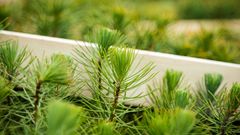

Poplars (Populus) are ornamental trees with characteristic silhouettes. Naturally occurring or deliberately planted, they are found almost everywhere throughout Europe, ranging from the Atlantic Coast to Western Russia. They can be found along river banks and in wetland areas.
Poplars are fast-growing trees, making them a valuable species in forestry, especially since the species is very tolerant of humidity. What's even more impressive is that poplars play an active role, similar to that of willows, in soil decontamination, as they dispel big quantities of water vapour. Therefore, they act as a filter between the water table and the water vapour they release into the air. This allows poplars to accumulate certain toxic particles. The trees partially filter or eliminate those toxic particles. For example, they can absorb and break down trichloroethylene (TCE), a common groundwater pollutant in industrial and urban areas.
Poplars can easily withstand high exposure to sunlight. They thrive in rich, cold, and wet soil. White poplars thrive well in flooded lands, as well as in humid and dry areas, and can even grow in poor and calcareous soils. Grey poplars can put up with dry soil, even sea spray. All poplar trees cope well with air pollution.
The planting method is very different from the method usually chosen for other species such as Oak or Douglas Fir, where rooted saplings are planted with shovels or pickaxes. Poplars, on the other hand, are planted from tree cuttings, where 3-4 meter long branches are planted using crowbars. The plantings often take place in the autumn, when the plant is at rest, as opposed to the spring when plantation is more difficult because the cutting requires water.
Poplar wood has a quality that makes it a useful and versatile material. It is a softwood that's easy to shape. It produces a white wood with hardly noticeable wood grain in matte or satin shades that are sought after for interior use. Poplar wood also has excellent mechanical resistance.
Thanks to qualities of the poplar timber, new methods of sustainable development, combining the wood's natural characteristics and technological advancements, have begun to be put into effect alongside more traditional uses.
Poplars are often referred to as the "tree of the people," coming from the Latin Populus and as important decisions were made under poplar trees, back in the days. According to European tradition, they are the connection to "the other world", to the afterlife, and are said to carry the meomory of people who have passed.
To the Druids, poplar trees symbolised the old age because of their white leaves. Poplars also associated with hope and the promise of revival. They are therefore both the ideal retirement gift or a gift one for someone who is about to begin a new chapter in their life.
Give an original gift, give a poplar tree!
Our goal is to enable anyone to do something that benefits nature and helps us to live in a more harmonious world. So why not become a tree owner in a European forest and help combat climate change?






Please note that this is promotional communication. See our notice of information.